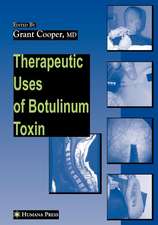Lupus: Molecular and Cellular Pathogenesis: Contemporary Immunology
Editat de Gary M. Kammeren Limba Engleză Hardback – 4 mai 1999
| Toate formatele și edițiile | Preț | Express |
|---|---|---|
| Paperback (1) | 2138.05 lei 6-8 săpt. | |
| Humana Press Inc. – 24 mar 2013 | 2138.05 lei 6-8 săpt. | |
| Hardback (1) | 2148.12 lei 6-8 săpt. | |
| Humana Press Inc. – 4 mai 1999 | 2148.12 lei 6-8 săpt. |
Preț: 2148.12 lei
Preț vechi: 2261.19 lei
-5% Nou
Puncte Express: 3222
Preț estimativ în valută:
411.05€ • 430.25$ • 342.12£
411.05€ • 430.25$ • 342.12£
Carte tipărită la comandă
Livrare economică 31 martie-14 aprilie
Preluare comenzi: 021 569.72.76
Specificații
ISBN-13: 9780896035560
ISBN-10: 0896035565
Pagini: 709
Ilustrații: XX, 709 p. 38 illus.
Dimensiuni: 178 x 254 x 48 mm
Greutate: 1.52 kg
Ediția:1999
Editura: Humana Press Inc.
Colecția Humana
Seria Contemporary Immunology
Locul publicării:Totowa, NJ, United States
ISBN-10: 0896035565
Pagini: 709
Ilustrații: XX, 709 p. 38 illus.
Dimensiuni: 178 x 254 x 48 mm
Greutate: 1.52 kg
Ediția:1999
Editura: Humana Press Inc.
Colecția Humana
Seria Contemporary Immunology
Locul publicării:Totowa, NJ, United States
Public țintă
ResearchCuprins
1 Lupus: The Clinical Entity.- 2 The Vascular Endothelium: A New Actor in The Pathogenesis of Vascular Injury in Systemic Lupus Erythematosus.- 3 Nitric Oxide in Systemic Lupus Erythematosus: Implications for Immunity and Inflammation.- 4 Molecular Mimicry, Altered Apoptosis, and Immunomodulation as Mechanisms of Viral Pathogenesis in Systemic Lupus Erythematosus.- 5 Clustering and Proteolytic Cleavage of Autoantigens in Surface Blebs of Apoptotic Cells: Implications for Pathogenesis of SLE.- 6 Immune Effects of Bacterial DNA and Their Possible Role in the Pathogenesis of Lupus.- 7 Genetics of Systemic Lupus Erythematosus.- 8 Genetic Insights into Murine Lupus.- 9 Murine Graft-vs-Host Disease: Relevance to Human Lupus Immunopathogenesis and Therapy.- 10 Lessons From Knockout and Transgenic Lupus-Prone Mice.- 11 B Cells in Systemic Lupus Erythematosus.- 12 Mechanisms of the Pathogenic Autoimmune Response in Lupus: From Mouse Models to Human Disease.- 13 T-Cell Autoimmunity in Lupus: Ignorance, Anergy, and Activation.- 14 T-, B-, and Natural Killer Cell Dysfunction in Murine Systemic Lupus Erythematosis Models.- 15 Mechanisms of T Helper Cell Activation and Function in Systemic Lupus Erythematosus.- 16 A Genetic Mechanism Underlying Deficient Type I Protein Kinase A Activity in Systemic Lupus Erythematosus T Lymphocytes.- 17 Impaired DNA Methylation in Lupus T Cells.- 18 Impaired Non—Antigen-Specific T-Cell Cytolytic Activity in SLE.- 19 Natural Killer Cells and CD8+ T Cells in the Downregulation of Antibody Production in Healthy Subjects and SLE: A Role for Transforming Growth Factor-? and Interleukin-2.- 20 Cytokines in the Immunopathogenesis of Lupus..- 21 Cytokine Gene Expression in Human Systemic Lupus Erythematosus.- 22 Balance Between Type 1 and Type 2Cytokine-Secreting Cells: Impact on Disease Activity in Systemic Lupus Erythematosus.- 23 Autoantibodies as a Source of Peptides That Regulate Autoantibody Production.- 24 Autoantibodies to Intracellular Antigens in Systemic Lupus Erythematosus Patients That Bind and Penetrate Cells.- 25 Pathogenesis of Autoantibody Production and Glomerulonephritis in Pristane-Treated Mice: An Inducible Model of SLE.- 26 Anti-DNA Antibodies: Markers of the Pathogenesis of Systemic Lupus Erythematosus.- 27 The Anti-DNA Response in Lupus: Structure, Initiation, and Pathogenesis.- 28 Glomerular Binding Antibodies in Systemic Lupus Erythematosus.- 29 The Antiphospholipid Syndrome: Mechanisms of Autoantibody-Mediated Thrombosis.- 30 Autoimmune-Associated Congenital Heart Block: Bringing Bedside Challenges to the Bench.- 31 Role of Calreticulin Autoimmunity in the Pathogenesis of Photosensitive Cutaneous Lupus Erythematosus.- 32 Complement System and Systemic Lupus Erythematosus.- 33 Type One Complement Receptor and Human SLE.- 34 Fc? Receptor Polymorphisms: Insights into Pathogenesis.- 35 Immune Complexes and Autoantibodies to C1q.- 36 Lipids and Lupus: The Fats of the Matter.- 37 Immunosuppressive Agents: Biologic Effects In Vivo and In Vitro.- 38 Treatment of Systemic Lupus Erythematosus by Selective Inhibition of T-Cell Function.- 39 Targeting Costimulatory and Other Signaling Molecules in Murine Lupus.- 40 Management of Murine Lupus by Correction of Fas and Fas Ligand—Induced Apoptosis: Therapeutic Rationale and Strategies.
Recenzii
"This effort represents a comprehensive and authoritative coverage of work on lupus. It is up to date in that the latest developments in the field are provided (e.g., the role of Fas and apoptosis in disease management). All workers in this area will find this a valuable resource. It also represents a worthwhile addition to medical libraries..." -4 Stars, Doody's Health Sciences Book Review Journal
"Firstly, the references quoted in the various chapters are well poised, with a mix of historical ones and very recent ones. Secondly, the authors were asked to keep in mind four issues while writing: their working hypothesis, the relationship between the hypothesis and the advancement of understanding of lupus pathogenesis, how novel information allows new insights in the field and where to direct research in the next 5 years...I strongly recommend reading this book. It has the major merit of presenting in a coordinated fashion many new findings on a disease that remains largely mysterious. This book has the potential to encourage cross-fertilization among researchers interested in the field of autoimmunity, and provides a valuable tool for newcomers to get a sense of the daunting problems that remain to be solved in order to better understand the regulation and dysregulation of the immune system." -Journal of Investigative Dermatology
"Firstly, the references quoted in the various chapters are well poised, with a mix of historical ones and very recent ones. Secondly, the authors were asked to keep in mind four issues while writing: their working hypothesis, the relationship between the hypothesis and the advancement of understanding of lupus pathogenesis, how novel information allows new insights in the field and where to direct research in the next 5 years...I strongly recommend reading this book. It has the major merit of presenting in a coordinated fashion many new findings on a disease that remains largely mysterious. This book has the potential to encourage cross-fertilization among researchers interested in the field of autoimmunity, and provides a valuable tool for newcomers to get a sense of the daunting problems that remain to be solved in order to better understand the regulation and dysregulation of the immune system." -Journal of Investigative Dermatology






















